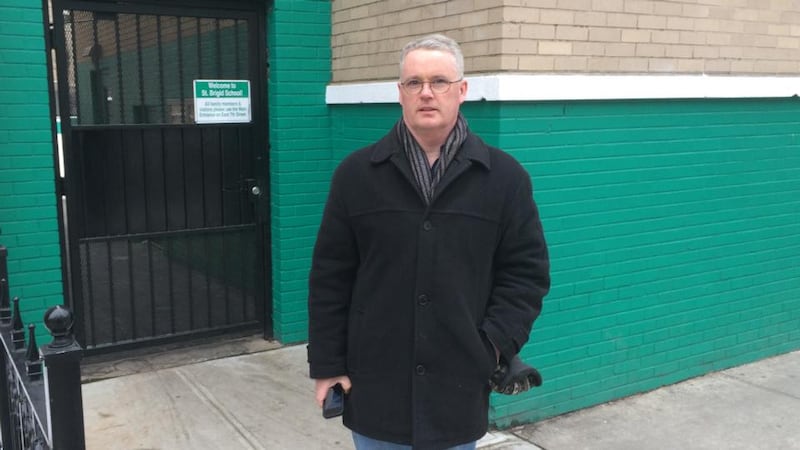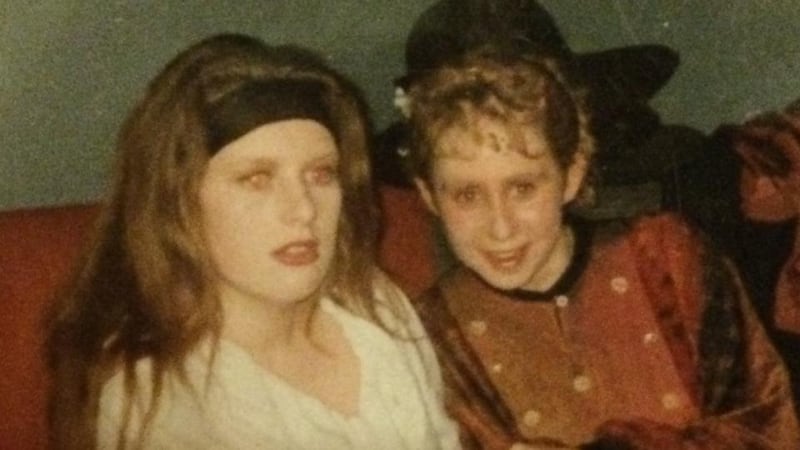On February 19th, 2011, a young Irish woman named Grace Farrell froze to death in the doorway of St Brigid’s church on the Lower East Side of Manhattan on what was the coldest night of that New York winter.
Except for the people who knew and loved her, Grace’s death was barely noticed in Ireland, initially earning just two lines in a national newspaper underneath that Saturday’s lottery numbers. She was 35.
Grace had emigrated from Ireland in the mid 1990s with dreams of making a new life in the United States. She also had one other major goal: to meet her mother.


When Grace was born her mother was unable to care for her, so after an initial attempt at adoption, which was never finalised, and a second foster-care placement that didn’t work out, she arrived at St Vincent’s, a Daughters of Charity children’s home in Drogheda.
When she was asked why the second foster home didn’t work out she replied, “Do you know the way you can’t put hot food into a cold fridge? Well, I was the hot food and the foster family was the cold fridge.”
She was seven years old. Grace’s mother, meanwhile, had left for the US.
Among the dozens of other children at the orphanage was a young man named Emmanuel Touhey. He arrived there in 1968 as an 18-month-old child, also because, like Grace’s, his mother was unable to look after him. St Vincent’s was where he would spend the best part of the next 20 years.
Emmanuel remembers Grace as a shy but fun-loving child. “She had a very loud and deep laugh, and she would be very mischievous, and she could have this terrible serious frown, and then this great guffaw would come out of her,” he says.
“I think she enjoyed her own company, but she also craved the company of others. You know, just like we all did, she wanted to feel loved and she wanted to feel secure.”
Happy years
Grace settled into the home, and by all accounts she had several happy years in the care of its nuns. When she was 11 or 12 she went to live with her paternal grandparents, nearby.
Her friend and cousin Diane recalls that Grace had been walking past her grandparents’ door to school each day without realising who they were. Once she moved in with them, Diane says, Grace entered a very happy and stable period.
“Her grandparents gave her such a wonderful life, they really did. They were so good to her. I mean, she really wanted for nothing.”
By the end of her teenage years, however, warning signs of Grace’s inner turmoil were beginning to show, mainly through her drinking. Shirley, another of Grace’s friends, remembers serious alcohol abuse.
“There was an instance one time when we had to bring her home because she was that drunk,” she says. “She had a bottle in her hand, and she fell and cut her whole hand, and it kind of did get to the stage where it was a lot of work to be out with her, because you were just constantly minding her, and I think that’s probably why we drifted apart.”
After she left school Grace went to England for a year, then returned to Ireland for a time before moving to the US to try to find her mother.
“It was always a big gap in Grace’s life,” says Shirley. “It was something that she always talked about, her mother in America, and I knew – I think we all knew – that she was going to go and try and find her mam and get closure.”
A few years before Grace decided to emigrate Emmanuel had made the same decision. After a number of unhappy years in Dublin, struggling to make ends meet while trying to break into radio journalism, he was allotted a green card in one of the American visa lotteries of the early 1990s.
Working his way through lower Manhattan, looking for work, Emmanuel got a job at Rosie O’Grady’s, an Irish bar near Times Square. His ambition to get back into what he loved doing most, covering politics, led him to the US capital.
“I moved down to Washington, and I used that as my base to network and to get to know people on Capitol Hill. I did an internship with the Senate foreign-relations committee, and that was the time when the whole peace process was going on in Ireland, so I got a front-row seat.”
Emmanuel thrived. He got a job with C-Span, the DC-based political news network, got married and started a family.
It was different for Grace: she found her mother in the Bronx, but things didn’t go smoothly, and the relationship was fraught.
One day, on the Lower East Side, Grace met a man named Albert Muñiz. “It must have been sometime around seven o’clock on July 4th, and I went out to get cigarettes,” he says. “I see these girls kicking her. She was on the floor, trembling, you know, and I said, ‘Hey, what are you doing? Are you crazy? Don’t be hurting her.’
“But then I walked away, and they walked away, and they left her there, but then something told me to just turn around. So she stood up, and she started trembling, really trembling, and she was all wet, and I said, ‘Excuse me, young lady, do you need help . . . Are you okay?’ She said, ‘No . . . and I do need help.’ ”
Albert took Grace in, and soon they were in a relationship. On September 20th, 1998, Grace had a boy, whom they named Oliver, and for a while she seemed to be settling down. But it was to be short-lived. Grace began drinking again, with homeless people in a nearby park.
Albert says she would sometimes go missing for weeks, even months. “She would disappear . . . I had to get flyers with her picture and go all over the East Side.”
Soup kitchens
Tompkins Square Park, on the Lower East Side, is popular with homeless people in New York. Mobile soup kitchens dispense hot food and charity workers distribute warm clothing several times a week.
On the night of February 19th, 2011, Grace found herself there on the coldest day of an exceptionally bitter winter. She settled into the alcove of a doorway outside St Brigid’s church, lying down on a couple of flimsy pieces of cardboard.
Fr Patrick Moloney, who is originally from Limerick, has been living beside Tompkins Square Park for nearly 60 years. He used to see Grace pass his door regularly, and he remembers the day clearly. “It was an extremely cold day. I wasn’t at all surprised,” he says about hearing the news of her death. “All I was told was that she was found in the doorway.”
He says those who hit rock bottom come from all sorts of backgrounds. “There’s no common denominator here. It reaches out to all kinds of people. So many of them will get that feeling of euphoria, and then they die of exposure, because they don’t feel the cold creeping in on them. That is very possibly what happened to that dear lady. She probably went in her sleep very peacefully – and tragically.”
Back in Ireland Grace’s friends heard the news of her death with disbelief. “A headline with ‘woman freezes to death’ just stabs at the heart of anybody who loved and knew her,” says Diane. “She wasn’t homeless; she chose to be away from her home, and I know her family came from that point of view as well, because the first question people ask is, ‘Where’s her family? Why did nobody help her?’
“And that’s just not how it was . . . She really did have a chance with her grandparents. They were so good, and the love that she got in that home . . . We’re never going to know the reason.”
In Washington DC Emmanuel also heard the news. Although he hadn’t seen Grace since they were at St Vincent’s children’s home, her death shocked him. Some of the reporting bothered him; he wanted her to be remembered as more than just another grim statistic.
He wrote about her in a New York Times blog. "I wanted people to understand that, yes, she was a statistic, but she was a person as well, and she had a difficult life that had combined and resulted in her early death on the streets of New York, and it was really a very sad story.
“I think that, despite how hard she tried and how much she hoped to live a life, one that she wanted to live for her son and for her family, the odds were against her from the beginning.”
Michael Kealy is a producer with RTÉ.
Documentary On One - Grace & Emmanuel is on RTÉ Radio 1 at 1pm on Saturday









